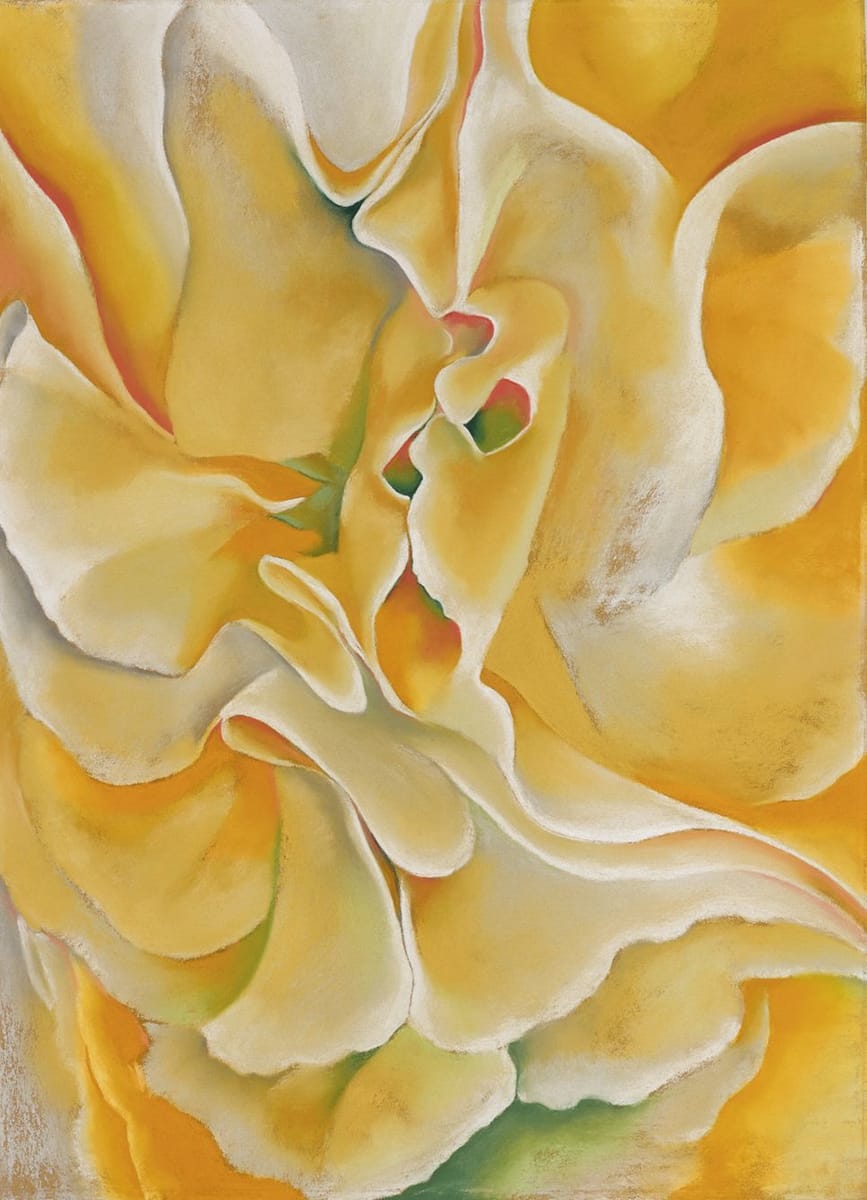

Yellow Sweet Peas
Georgia O'Keeffe
In 1922 Georgia O’Keeffe proclaimed, “I made up my mind to forget all that I had been taught, and to paint exactly as I felt.” The considerable possibilities offered by the floral subjects for which she would become best known had been underscored by her teacher, Arthur Wesley Dow, who advised his students to make “not a picture of a flower…--that can be left to the botanist—but rather an irregular pattern of lines and spaces, something far beyond the mere drawing of a flower from nature.” For O’Keeffe the varied, organic forms of flowers and other natural objects provided fodder for personal expression, “I found that I could say things with color and shapes that I couldn’t say in any other way—things that I had no words for.” Reflecting the formal vocabulary O’Keeffe developed as an avant-garde American modernist in the early decades of the 20th century as well as her reverence for the natural world, Yellow Sweet Peas masterfully exemplifies the deeply personal synthesis of realism and abstraction that defines her work.
During the 1920s, O’Keeffe began painting the images for which she is perhaps best known: large-scale compositions of magnified leaves and flowers – she was particularly drawn to flowers for what she felt was the challenge they inherently posed to human observation. It was easy, she believed, to overlook the beauty found in the details of these small and delicate entities. Later recalling her initial attraction to this motif she said, “So I said to myself—I’ll paint what I see—what the flower is to me but I’ll paint it big and they will be surprised into taking time to look at it—I will make even busy New Yorkers take time to see what I see of flowers.”
Yellow Sweet Peas with its sensual modulations of color, sensuous curves and folds is a meditation on form and design that reveals O’Keeffe’s mastery of the pastel medium. Pastel was highly important in O’Keeffe’s oeuvre and allowed her to create a velvety, tactile surface that was impossible to capture with oil paints. Following early experimentation with charcoal and watercolor, she began working in pastel in 1915, discovering that she could attain the subtle tonality of charcoal without forsaking the intensely vibrant palette she had employed in her early watercolors. “Pastel afforded O’Keeffe a medium for her most unabashedly beautiful works of art.”
In Yellow Sweet Peas, O’Keeffe combines rich hues of yellows highlighted by whites and bold passages of deep oranges and greens. The work is a study of texture as O’Keeffe masterfully varies her application of the pigment, oscillating from dense, velvety opacity to lightly feathered strokes that reveal the paper support. She uses delicate, yet precise lines to define the various forms of the composition and isolates the flower, closely cropping the image to focus on it various forms - rapturous, unfurling and fluttering petals, fluted edges, delicate curves. As she renders the sweet pea monumental and centralized, O’Keeffe eschews traditional scale and pictorial organization, compressing the space and confronting the viewer with the blossom’s commanding color and form, and transforming this traditional still-life subject into an abstract pattern of organic shapes. The distinctive composition O’Keeffe employs in Yellow Sweet Peas correlates closely to the work of many modern photographers in the early decades of the 20th century. Like Stieglitz, Strand and Edward Weston, O’Keeffe focuses closely on her chosen subject, isolating the blossom from its larger environment to examine its form and color at close hand. Pulsating with visual energy, the work suggests O’Keeffe’s belief in the rhythms and dynamism of nature itself.
O’Keeffe wrote: “Long ago I came to the conclusion that even if I could put down accurately the thing I saw and enjoyed, it would not give the observer the kind of feeling it gave me. I had to create an equivalent for what I felt what I was looking at—not copy it.” As she simplifies, crops, and enlarges the sweet pea, O’Keeffe leaves the realm of pure objectivity to present her perception of its essence, ultimately compelling the viewer to experience the natural world in a new and more profound way.
(http://www.sothebys.com/en/auctions/ecatalogue/2017/impressionist-modern-art-evening-sale-n09740/lot.26.html)
Uploaded on Nov 22, 2017 by Suzan Hamer
Arthur
coming soon